
AM LIMIT ZIEHEN
Schau zu, wie Connor am Empath-Felsen in Kirkwood, Kalifornien, ein weiteres legendäres Testpiece abräumt.
Du hast schon ein Konto?
Melde dich an, um schneller auszuchecken.
Add 100 EUR more to quality for free Shipping!
€0,00 EUR
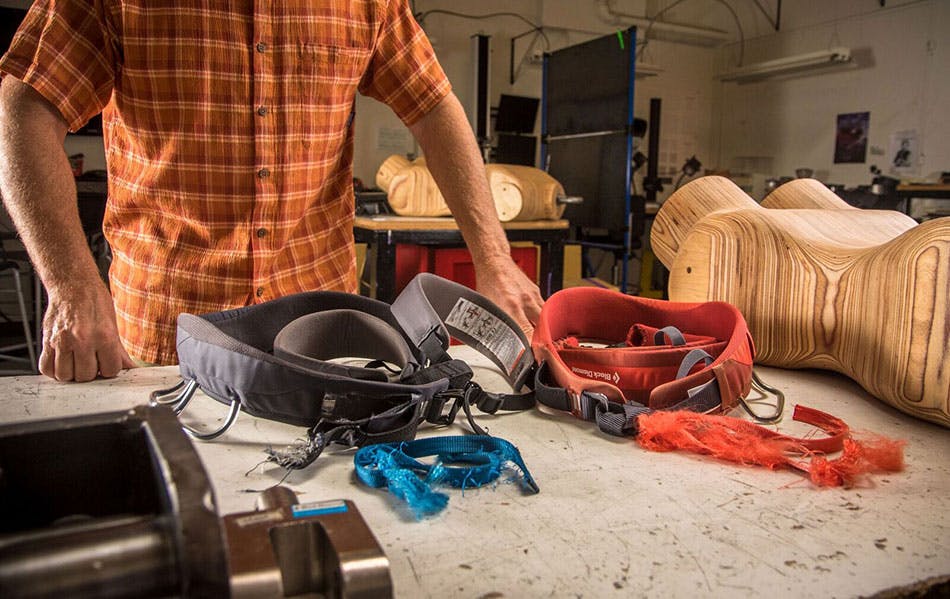
In diesem QC Lab schauen wir uns vier verschiedene Kundenproduktfragen an:
```
Haftungsausschluss
```: Wie immer ist das nicht als endgültige Aussage gedacht. Stattdessen handelt es sich um ein schnelles und grobes Testen und ein paar Daten, die etwas Licht in die Fragen bringen und zum Nachdenken anregen sollen. Wir verwenden im Grunde genommen einen Datenpunkt des fraglichen Produkts und einen Datenpunkt eines neuen Vergleichsprodukts. Also brauchst du BD echt nicht mit E-Mails und Kommentaren zu bombardieren, dass das unvollständig und statistisch nicht relevant ist – das wissen wir bereits.
Hinweis: Zur Info: Manche Leute denken lieber in Kilonewton, andere in Pfund – deswegen beziehen wir beide Maßeinheiten ein. 1kN = 224.8 lbf.
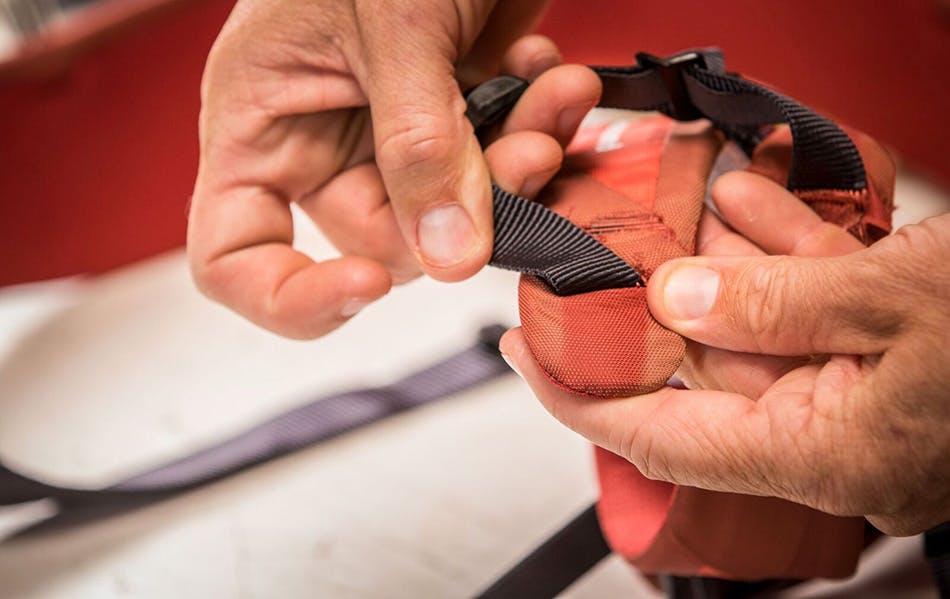
Ein Einzelhandelsgeschäft hat einen brandneuen Black Diamond Momentum-Gurt in seinem Schaufenster ausgestellt. Nach einigen Monaten, als sie ihre Ware austauschten, fiel ihnen auf, dass der rote Gurt ausgebleicht war. Sie fragten sich, ob sie den Gurt rabattieren und trotzdem weiterverkaufen oder wegwerfen sollten. Beeinflusst das Ausbleichen der äußeren Schicht durch die Sonne die Stärke und/oder Leistung?
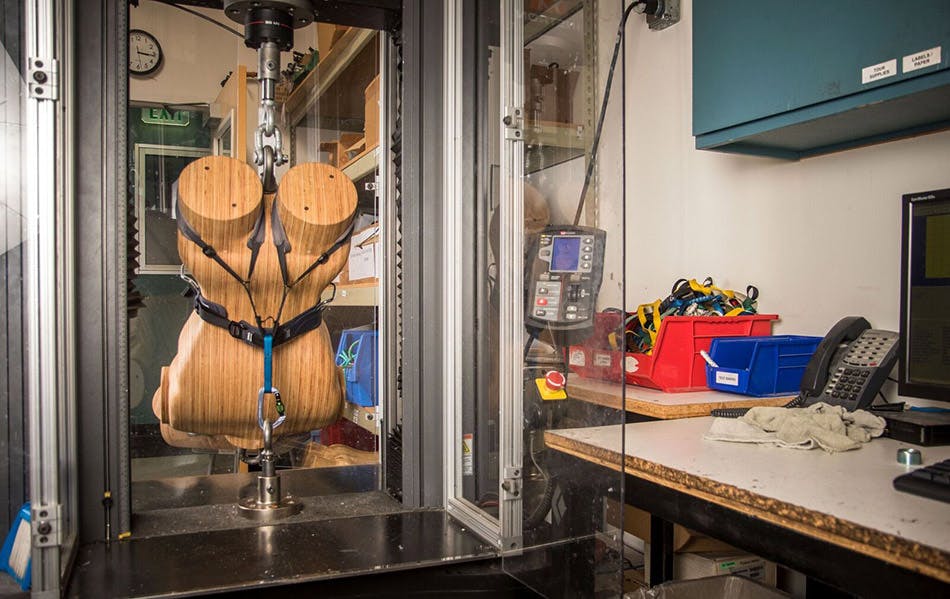
Da bei jedem Test nur ein Datenpunkt vorliegt, ist es eigentlich nicht relevant zu sagen, dass der eine stärker als der andere ist. Der sonnengebleichte Gurt hat aber den Belastungstest und alle Komponententests bestanden. In Wirklichkeit liegen alle angezeigten Werte grundsätzlich in dem Bereich, den man auch bei einem neuen Gurt erwarten würde. Das soll nicht heißen, dass Sonnenlicht die Festigkeit nicht beeinträchtigen kann. Tatsächlich kann es das – wie in einigen früheren QC-Labor-Artikeln zu sehen war. Wichtig ist hier zu erkennen, dass die Bauweise des Gurts einen Unterschied machen kann. Dieser spezielle Gurt hat eine tragende Webstruktur, die von einer bequemen, gepolsterten Hülle umgeben ist. Der am stärksten verblasste Teil des Gurts war die gepolsterte Hülle (der rote Teil), die tatsächlich keinerlei Festigkeit bietet.
Wenn dies ein anderes Geschirr wäre oder vielleicht in einer anderen Ausrichtung gedreht würde, sodass mehr vom strukturellen Gurtband (zum Beispiel des Hüftgurtes) der Sonne ausgesetzt wäre, dann könnte es sein, dass wir eine Verringerung der maximalen Festigkeit feststellen.
Also, auch wenn in diesem Fall die Sonne scheinbar nicht wirklich die Festigkeit des Gurts beeinflusst hat, sei dir sicher, dass sie strukturelle Gurte definitiv so ausbleichen kann, dass du eine Verringerung der Festigkeit feststellst. Wenn deine lebenswichtige Ausrüstung durch die Sonne ausgeblichen wird, ist es in der Regel am besten, vorsichtig zu sein und sie auszusondern und zu ersetzen.
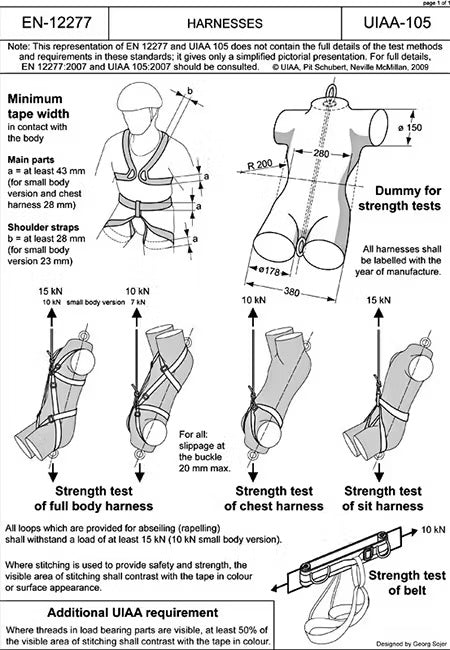
We performed the standard CE/UIAA tests, which can be found here:http://theuiaa.org/wp-content/uploads/2016/08/UIAA-105-Harnesses_May-2014.doc2_.pdf
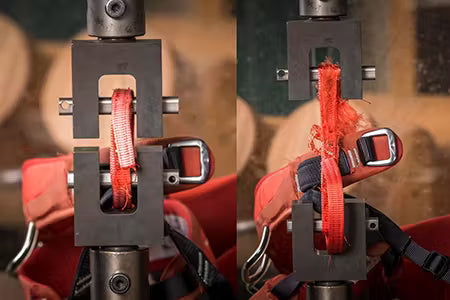
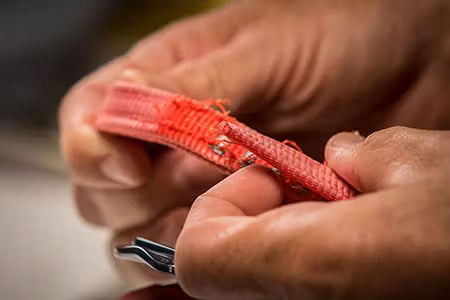
Observations, Thoughts and Comments
With only one data point on each test, it’s not really relevant to say one is stronger than the other. However, the sun-faded harness passed the proof test and all component tests. The reality is that all values shown are basically within the range of what we would see for a new harness. That’s not to say that sun fading can’t affect strength. It most certainly can as can be seen in some previous QC lab articles. What’s important here is to realize that the construction of the harness can make a difference. This particular harness has structural webbing that is covered by a comfortable padded shell. The most visibly faded part of the harness was the padded shell (the red part), which actually doesn’t provide any strength.
If this were a different harness, or perhaps rotated in a different orientation so more of the structural webbing (waist belt for example) was exposed to the sun, then it is possible that we could see a reduction in ultimate strength.
So, though in this case, the sun didn’t appear to really affect the strength of the harness, make no doubt that sun can definitely fade structural webbing to a point where you see a reduction in strength. If your life-dependent gear is getting sun-faded, it’s usually best to be conservative and retire and replace.
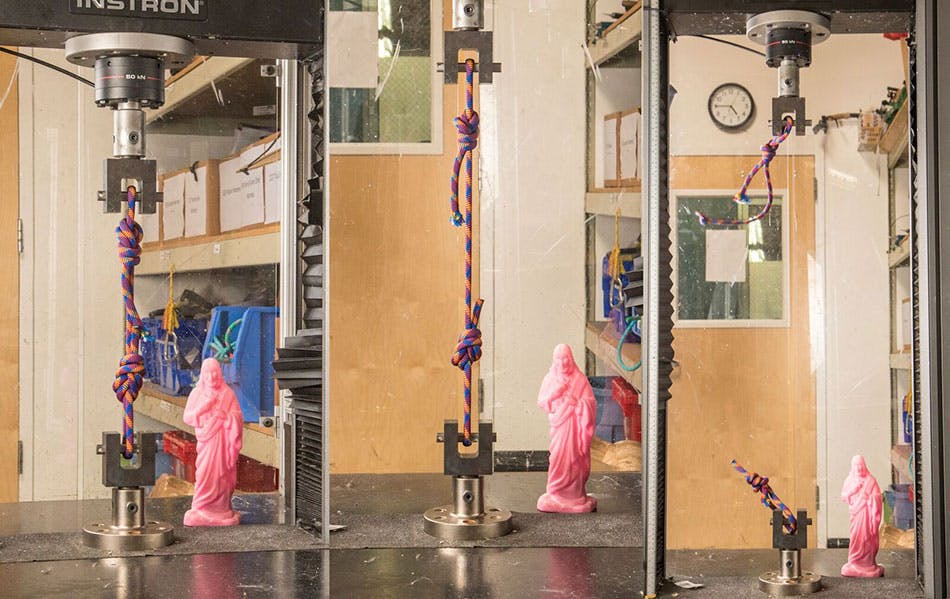
20-JÄHRIGES UNBENUTZTES SEIL
Vor einer Weile hat mir ein Typ eine E-Mail geschickt, nachdem er ein ‚brand new OLD‘ Seil in seinem Keller gefunden hatte. Es wurde richtig gelagert (kühler, trockener Ort). Es war noch nie benutzt worden und er fragte, ob es sich genauso verhalten würde wie ein neues.
Vor einigen Jahren hatte ein langjähriger BD-Mitarbeiter dieselbe Frage. Er hatte ein nagelneues, 20 Jahre altes Seil – also brachte er es vorbei und wir haben es getestet. Damals haben wir es im Hinblick auf die maximale Zugfestigkeit mit einem Seil ähnlichen Durchmessers verglichen und festgestellt, dass es im Grunde so war, als wäre es neu. Wir haben uns entschieden, dasselbe mit diesem Seil zu machen.
Wir haben den Durchmesser als ein solides, altmodisches 10,5 mm gemessen und mussten ein wenig suchen, um im Büro etwas ganz Neues mit einem ähnlichen Durchmesser zu finden. Ich konnte eigentlich nichts im beefcake 10,5 mm finden, aber ich habe unser Neuestes für nächstes Jahr – den Black Diamond 10,2 mm Cord – aufgespürt. Dieses Mal haben wir drei ganz schnelle und grobe Tests durchgeführt:
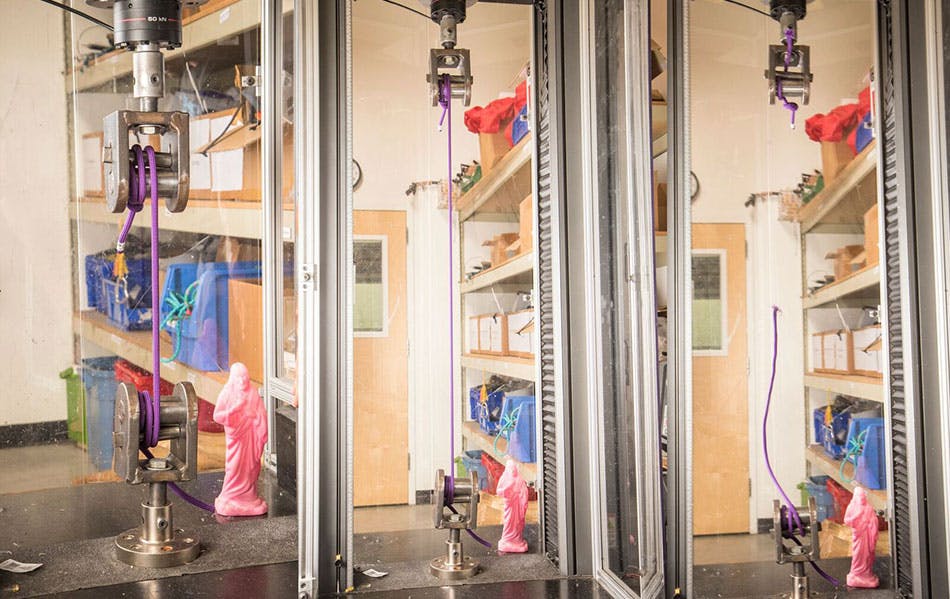
Einmal mehr, mit im Grunde genommen nur einem Datenpunkt pro Test, sieht es so aus, als würde das 20 Jahre alte neue Seil fast so performen, als wäre es erst gestern hergestellt worden. Das waren dieselben Ergebnisse, die ich vor ein paar Jahren erzielt habe, als ich ein altes, aber unbenutztes Seil getestet habe, das richtig gelagert wurde.
Das alte, ungenutzte Seil spiegelte ziemlich genau die Ergebnisse des neuen Seils wider:
Es ist wirklich unglaublich, wie nah die Ergebnisse beieinander lagen – aber wir müssen bedenken, dass es sich nur um einen einzigen Datenpunkt handelt und dass wir hier nicht genaue Proben vergleichen – das alte Seil misst 10,5mm, und das neue 10,2mm von einem anderen Hersteller mit vermutlich anderer Konstruktion. Es ist wichtig, diese Information als Richtungsanzeiger zu sehen, um ein wenig Einblick zu geben.
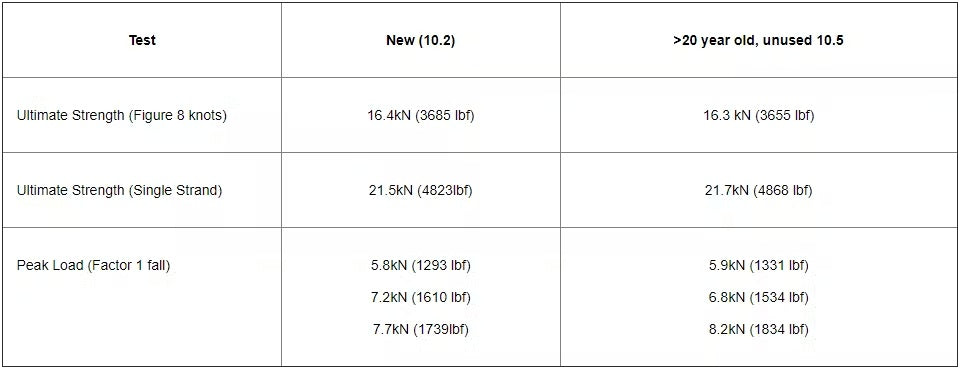
Results
Observations, Thoughts and Comments
Once again, with pretty much only one data point in each test, it would appear that the 20-year-old new rope performs pretty much as if it was made yesterday. These were the same results I had a few years ago when testing an old, but unused rope that had been stored properly.
The old, unused rope pretty much mirrored the results of the new rope:
It’s actually unbelievable how close the results were—but we do need to remember that we’re talking about only one data point, and we’re not comparing exact samples here—the old rope is 10.5mm, and the new one is 10.2mm from a different manufacturer with likely different construction. It’s important to think of this information as directional—to give some insight.
I was doing some digging on the internet about the behavior of old, but unused ropes and found this from the Tendon website:
In the process of rope production, the fibres are mechanically doubled, twisted and braided in several stages. In this way the fibres finally attain a condition of mechanically induced stress. A long-term storage leads to retardation and relaxation. This means that stress in macromolecules is “relieving”. This phenomenon is not harmful, on the contrary it is connected with an improvement of dynamic properties. Research works showed that the results of tests of dynamic performance of ropes that had been (optimally) stored for several years were often better than values measured immediately after production. Polyamide also does not contain additives and softeners like, for example, PVC that could diffuse out. This is the reason why no embrittlement occurs.
So should you go climbing on an old, but un-used piece of gear? Well, ultimately it’s up to you. Chances are technology has changed and there is better gear on the market. In this case, this rope is considered super fat by modern standards and most folks wouldn’t be psyched to carry a big old cord like that to the crag, much less have a belay device that worked properly with it. Plus, as we all know, climbing is a serious game, so if you’re ever in doubt about your rope, or any piece of gear—it’s probably best to retire it.
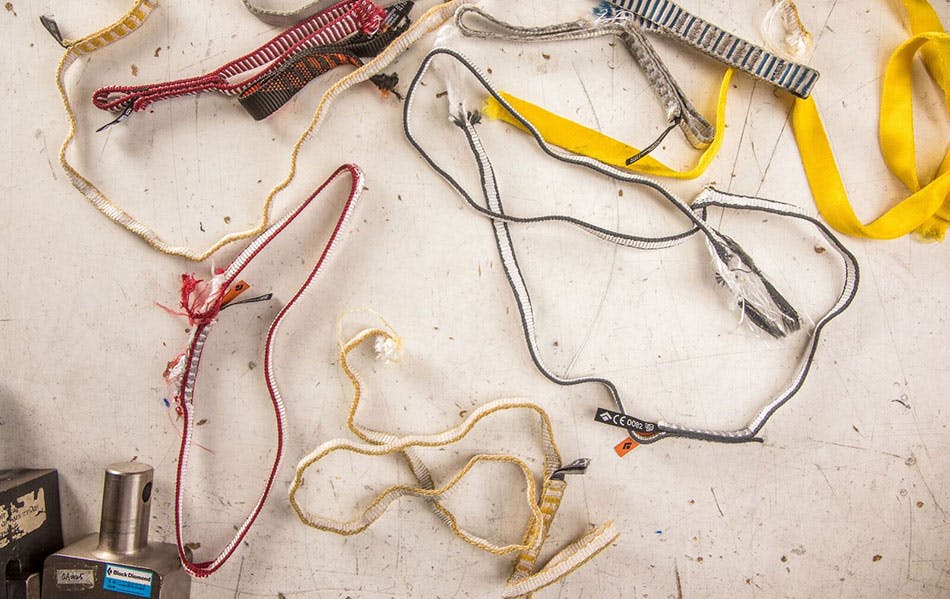
Bei der Seilherstellung werden die Fasern in mehreren Stufen mechanisch verdoppelt, gedreht und geflochten. So erreichen sie schließlich einen Zustand mechanisch induzierter Spannung. Eine langfristige Lagerung führt zu einer Verzögerung und Entspannung – das bedeutet, dass sich die Spannungen in den Makromolekülen abbauen. Dieses Phänomen ist nicht schädlich, im Gegenteil, es verbessert die dynamischen Eigenschaften. Forschungsarbeiten haben gezeigt, dass die Ergebnisse der Tests zur dynamischen Leistungsfähigkeit von Seilen, die über mehrere Jahre (optimal) gelagert wurden, oft besser waren als die unmittelbar nach der Produktion gemessenen Werte. Polyamid enthält außerdem keine Zusatzstoffe und Weichmacher wie zum Beispiel PVC, die herausdiffundieren könnten. Deshalb kommt es auch nicht zur Versprödung.
Also, solltest du beim Klettern auf alte, aber unbenutzte Ausrüstung setzen? Letztendlich liegt es an dir. Wahrscheinlich hat sich die Technologie weiterentwickelt und es gibt bessere Ausrüstung auf dem Markt. In diesem Fall wird dieses Seil nach heutigen Standards als richtig dick angesehen und die meisten Leute wären nicht begeistert davon, so ein dickes, altes Seil zum Felsen zu bringen – ganz zu schweigen von einem Sicherungsgerät, das damit richtig funktioniert. Und wie wir alle wissen, ist Klettern kein Kinderspiel, also wenn du jemals Zweifel an deinem Seil oder an irgendeinem Ausrüstungsgegenstand hast, ist es wahrscheinlich am besten, es in den Ruhestand zu schicken.
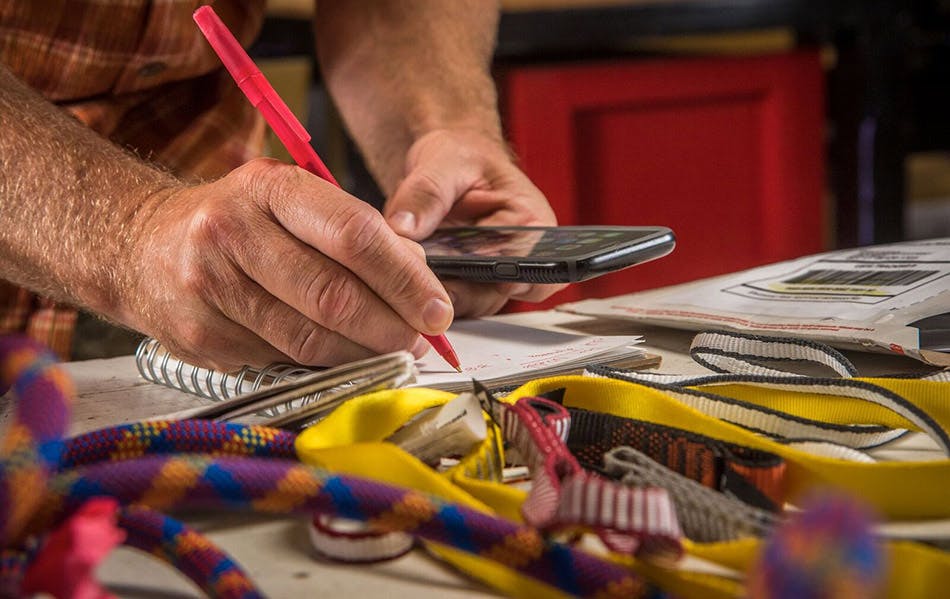
Das Rack meines Kumpels ist echt peinlich. Vor ein paar Jahren ging ich mit ihm zum Diamond klettern und konnte gar nicht glauben, was für ein zusammengewürfelter Schlamassel er sein Rack nannte. Seitdem hat er es langsam zu etwas Vernünftigem ausgebaut. Allerdings zog er es beim letzten Mal, als wir zusammen kletterten, wieder heraus und er begann sich wegen des Zustands seiner Schlingen unwohl zu fühlen. Ich habe seine Schlingen durch neue ersetzt und ihm gesagt, dass wir sie testen, damit er sehen kann, ob seine Befürchtungen berechtigt sind.
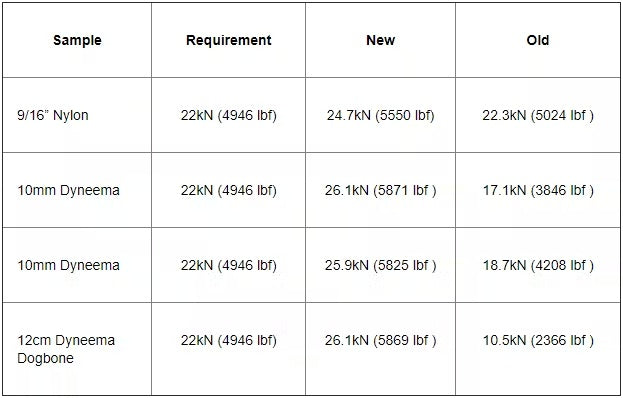
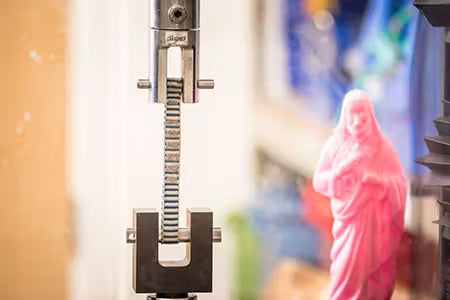
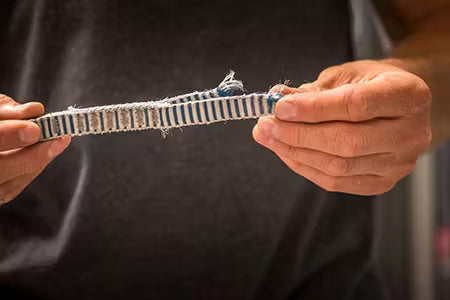
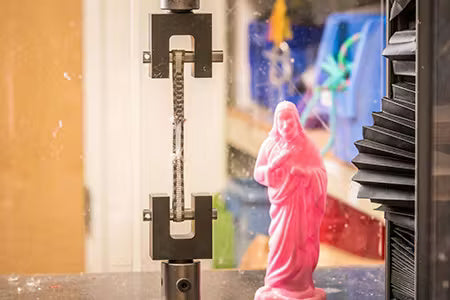
Observations, Thoughts and Comments
In general, though Jon Webb’s gear looked a bit beat, in MOST cases it was still actually quite strong. No, the slings didn’t always meet the requirement of 22kN, but they weren’t really near the point where it would become a safety concern under normal use.
EXCEPT …
For his EXTREMELY old and faded Dyneema Dogbone from the mid-90s. To be fair, Jon wasn’t actually climbing on this one—it was just in his pack. But it’s worth a closer look. A new sewn sling must meet 22kN, and our one new data point was over 26kN (pretty typical). Jon’s old dyneema sling checked in at 10.5kN. Now that’s getting sketchy! It’s lost over half it’s strength—from being faded by the sun, abrasion, use and age. Measuring 10kN IS a load that you could see in the field—so this qualifies as a sketchy piece of gear that shouldn’t be used—and as I said, wasn’t being used.
So other than that one, fairly obvious, old dogbone—the reality of his particular gear is that it LOOKED a bit worn, frayed and beat, though, in this case it tested to be plenty strong for typical use. Once again, the psychological affect is important. When you’re talking about life-critical equipment, it’s best to not have uncertainties lingering in the back of your mind—that way you can focus on the climbing. When in doubt, throw it out.
The real issue in this case is why was this old sketchy dogbone in Jon Webb’s pack at all? A good lesson here is IF you’re going to retire an old piece of gear, it’s best to fully destroy it so it can’t get mistaken for a functional piece and inadvertently be used in the field.

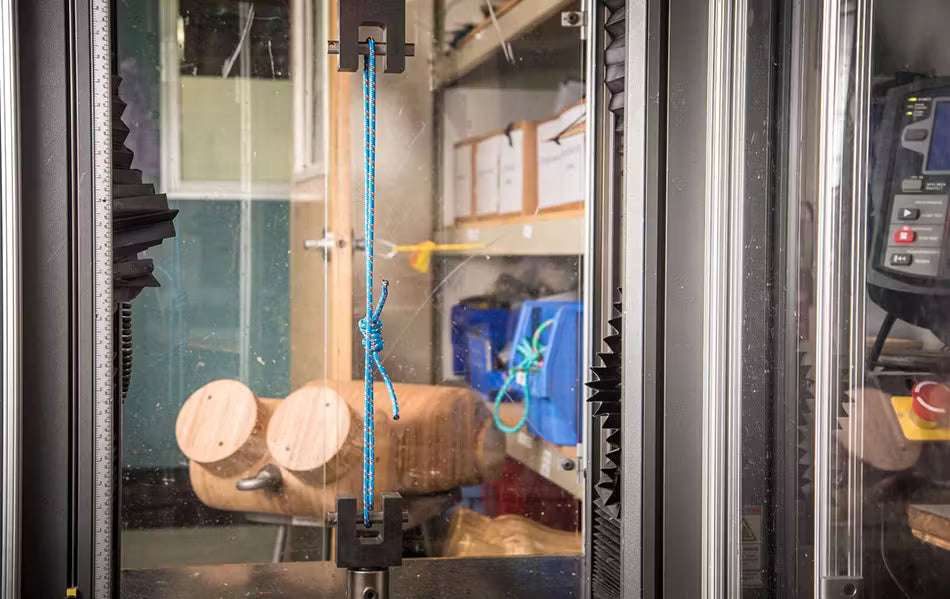
Here is an email exchange between a climber & BD customer and myself...
Customer:
I am a big BD fan and longtime user of all types of BD gear.
I enjoyed the Enormo Podcast that you did and thought of you when this situation came up.
I was on a climbing course last week and the instructor had 12 students rap off of a tree anchor. I got put on a pre-rigged 4 person Rap that had the potential for everyone to load the rope/anchor if someone lost their footing and yanked everyone else.
I was not keen on the tat and being hard into the rope with 3 other people. We had a discussion where I felt my concern was dismissed. I went back today, replaced the anchor with new cord, and cut the old cord off. One piece of 6mm cord and a ½” sling that had the date 12/14 written on it.
Is there any way I can send this to you to do a strength test? It would be great and a potential learning experience for all involved.
Thanks for the consideration.
KP:
sure
send it over
please include a copy of this email
note: on one hand gear is burly
on the other hand, gear doesn’t last forever
under normal loading scenarios - I wouldn’t be worried about that sling - loads when rapelling are quite small
but you’re right - shock loading is a different story
though nylon does absorb some energy…
my guess is though, that you guys all would have been fine
in a static test - i’m going to throw a dart and say the sling goes at >14kN
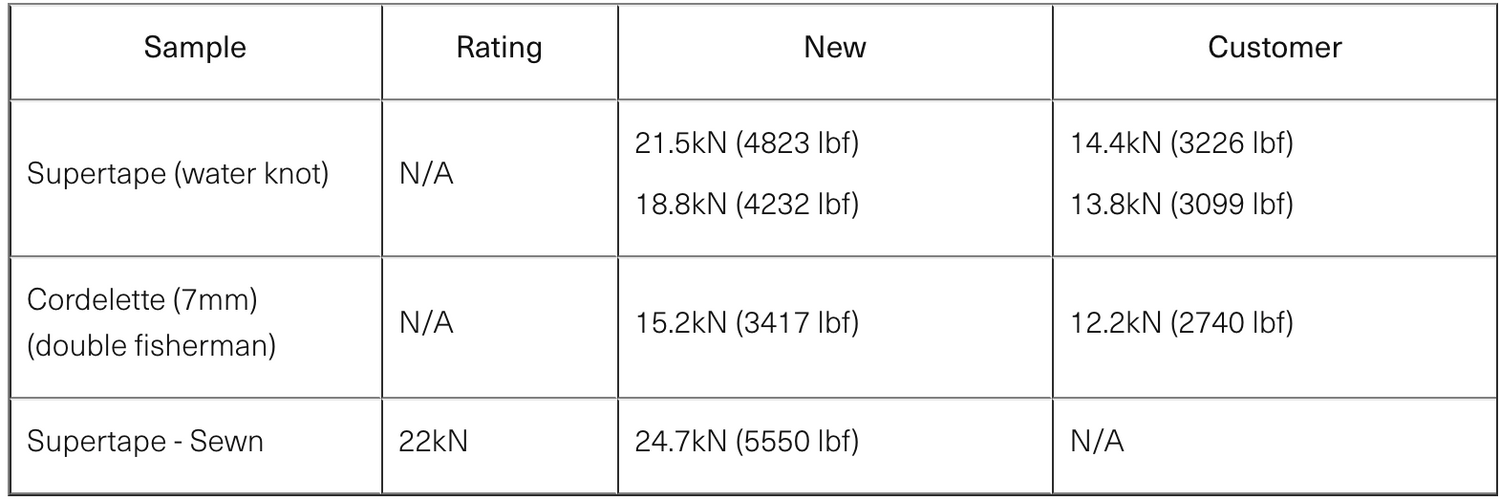
Results:
KP:
we tested using standard 10mm pins
I tied the cord in a double fisherman’s
and the webbing, I cut it in half and tied using a water knot
the cord
- broke at pin
- 12.2kN (2740lb)
the 9/16” Supertape
- sample 1 - broke at pin - 14.4kN (3226lb)
- sample #2 - broke at pin - 13.8kN (3099lb)
Looks like my guess of 14kN from my original email wasn’t too far off
so static loading with the members of your team all clipped in - no real problem
even dynamic loading - would be tough to get to those loads - especially given the fact that the materials stretch and absorb energy under dynamic loading
regardless
good on ya for replacing old tat.
hope that helps
KP
Since my response we tested a few more new pieces for comparison sake:
Observations, Thoughts and Comments
From the customer:
Thanks so much to you and to BD! Shows your commitment to safety and to the end users.
Nothing like empirical data to make good decisions!
I am surprised how strong the old 9/16” webbing was.
My perceived risk vs the real risk just got re-set.
Once again—we are looking at one data point of the customer’s slings and cordelette versus what they could do when new, and then even comparing sewn slings to knotted slings. Yes, there was a decrease in strength, but as I mentioned in my emails to the customer, in NORMAL circumstances, an anchor used for rappelling shouldn’t see loads nearly that high. Typical rappelling loads are only two or three times body weight, when bouncing down a rappel. Of course this depends on the rope (static vs dynamic), size of load, etc … but GENERALLY speaking, the rappelling loads don’t get into the double digit kN realm.
Hats off to this gentleman who took it upon himself to go back the next day and replace the slings on that rap! It’s always a good idea to carry a knife and some cord so that you can replace suspect slings in the mountains. In the grand scheme of things, it’s incredibly cheap and only takes a few minutes.
So four different user questions and four quick and dirty experiments which hopefully help shed some light:
A sun faded harness from a display window at a retail store. Does the sun affect the strength of a harness?
In this case not really, but it could, depending on the construction of the harness, orientation to the sun and how much UV it was exposed to. There is no doubt that sun-exposed webbing becomes weaker with time.
An un-used properly stored rope that is over 20 years old. Can I still climb on this cord, or should I pony up and buy a new one?
In our limited testing, this rope performed as if it was manufactured yesterday, but if it was me, I’d opt for a new higher tech cord that didn’t have me wondering about its integrity or longevity in the back of my mind.
Some slings that my buddy had on his rack and thought were looking a bit sketchy. Just because they’re ratty, should I continue using them or get some replacements?
Most of these slings were ok, and could have been climbed on longer, however, one was definitely in the sketchy zone. It’s good to remember that it’s not always easy to tell how beat or worn something is, and once again, if life-dependent gear visually looks suspect, it will affect your mind when you’re climbing, and it may be best just to replace it. And if you’re going to retire a piece of gear, best to ensure that it’s fully destroyed and thrown away so it can’t get confused with your good, usable gear.
Some webbing and cordelette that a climber was anchored to at a belay that kind of freaked him out. Four climbers at a tree belay clipped to some webbing and cordelette. Any reason for concern?
The fact that the webbing was dated (outside of the loading zone) was great and could give you a reference for how long it had been out, which was just over two years. It tested slightly weaker than if it was new, but still plenty strong for the intended application of rappelling. With years of sun exposure, this webbing would undoubtedly weaken with time, so it’s always good to be aware, inspect fixed gear, and replace if in doubt.
It’s not always easy to ascertain the structural integrity of something: you likely don’t know the detailed past – was it stored properly? How long was this webbing fixed on this route? How much sun and/or abrasion did it see?
The reality is, though gear is burly, and if taken care of appropriately it’ll last a long time, we can’t forget that it won’t last forever.
Be safe out there,
KP

Schau zu, wie Connor am Empath-Felsen in Kirkwood, Kalifornien, ein weiteres legendäres Testpiece abräumt.

Stell dir dein perfektes Outdoor-Outfit zusammen – egal ob strahlender Sonnenschein oder Schneesturm.

Black Diamond Athletin Angela Hawse ist eine Wegbereiterin für Veränderung.

Das brauchst du für jede Art von Skitouren-Abenteuer.

Stell dein Setup für die nächste Skitour perfekt ein.

Begleite BD-Athlet Yannick Glatthard tief in die Schweizer Alpen, während er seine Heimatberge mit guten...
Begleite BD-Athlet Yannick Glatthard tief in die Schweizer Alpen, während er seine Heimatberge mit guten Freunden teilt.

Begleite Dorian Densmore und Mya Akins durch eine weitere Wintersaison voller steiler Alaska-Spines, versteckter Backyard-Couloirs...
Begleite Dorian Densmore und Mya Akins durch eine weitere Wintersaison voller steiler Alaska-Spines, versteckter Backyard-Couloirs und tiefer Abenteuer in den Bergen.

Wir bringen Licht ins Dunkel, wenn’s um Stirnlampen geht.

Schau dir an, wie BD-Athlet Alex Honnold hoch über Tahoe beim harten Trad-Klettern alles gibt.


Unverzichtbare Bekleidung für den Herbst.

2012 haben Filmemacher und Fotograf Ben Ditto und Profikletterer Mason Earle eine makellose Linie im...
2012 haben Filmemacher und Fotograf Ben Ditto und Profikletterer Mason Earle eine makellose Linie im Hochland von Tuolumne eingerichtet. Doch ihre Versuche, die Route frei zu klettern, wurden jäh gestoppt, als sich Masons Leben komplett veränderte. Mit Unterstützung von Connor Herson fanden Ditto und Mason einen Weg, den Traum von dieser Kletterausrüstung weiterleben zu lassen.
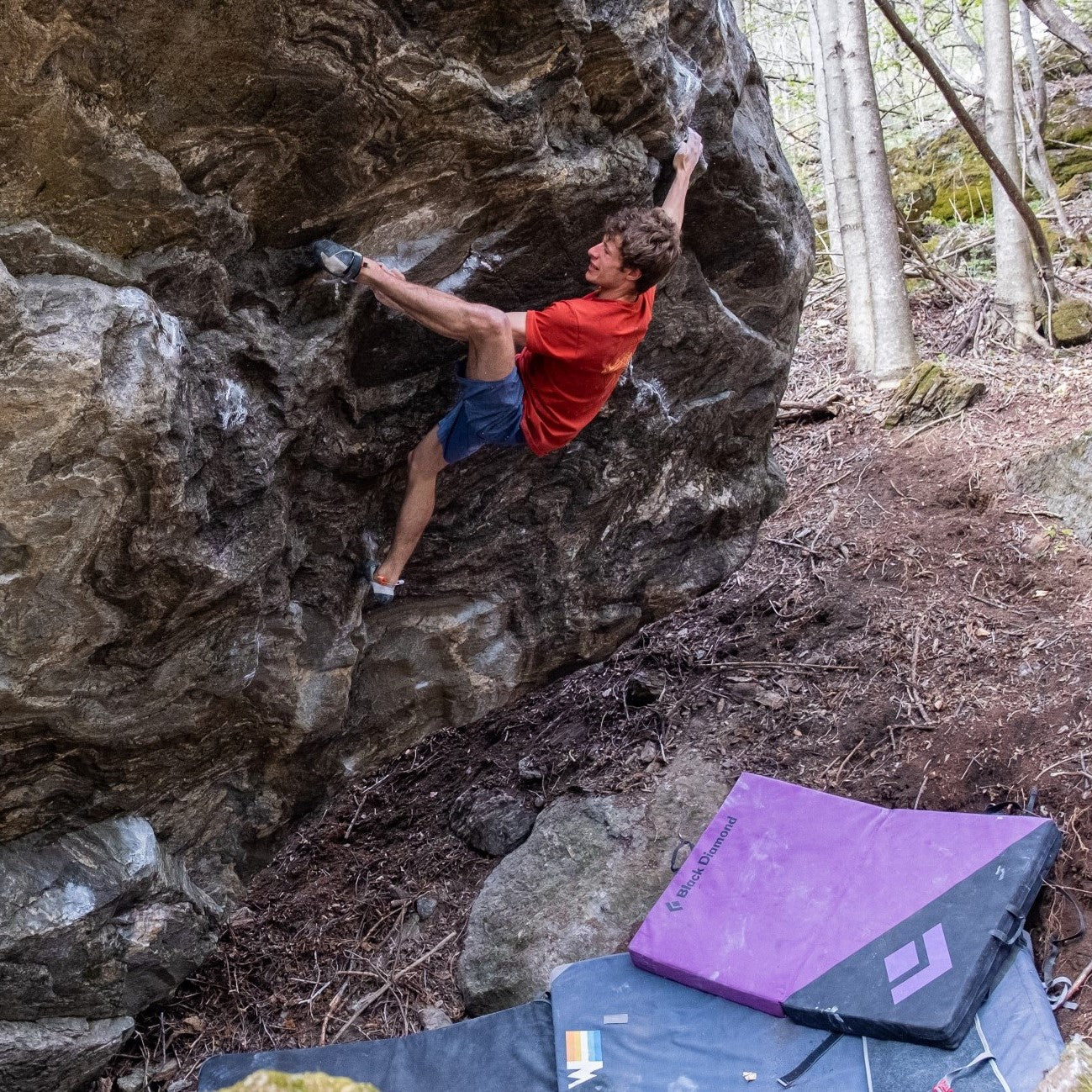

Schau zu und lerne, wie unser Field Test Coordinator dir Schritt für Schritt zeigt, wie...
Schau zu und lerne, wie unser Field Test Coordinator dir Schritt für Schritt zeigt, wie du jedes STS-Style Black Diamond Fell zuschneidest und montierst.
